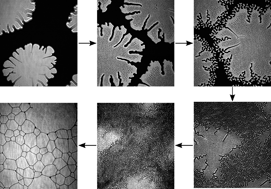Microphase formation at a 2D solid–gas phase transition
Abstract
Density modulated micro-separated phases (microphases) occur at 2D liquid interfaces in the form of alternating regions of high and low density domains. Brewster angle microscopy (BAM) images demonstrate the existence of microphases in cluster, stripe, and mosaic morphologies at the buried interface between hexane and water with fluoro-alkanol surfactant dissolved in the bulk hexane. At high temperature, the surfactant assembles at the interface in a 2D gaseous state. As the system is cooled additional surfactants condense onto the interface, which undergoes a 2D gas–solid phase transition. Microphase structure is observed within a few degrees of this transition in the form of clusters and labyrinthine stripes. Microphases have been observed previously in a number of other systems; nevertheless, we demonstrate that adsorption transitions at the liquid–liquid interface provide a convenient way to observe a full sequence of temperature-dependent 2D phases, from gas to cluster to stripe to mosaic to inverted stripe phases, as well as coexistence between some of these microphases. Cracking and fracture of the clusters reveal that they are a solid microphase. Theories of microphases often predict a single length scale for cluster and stripe phases as a result of the competition between an attractive and a repulsive interaction. Our observation that two characteristic length scales are required to describe clusters whose diameter is much larger than the stripe period, combined with the solid nature of the clusters, suggests that a long-range elastic interaction is relevant. These results complement earlier X-ray measurements on the same system.


 Please wait while we load your content...
Please wait while we load your content...